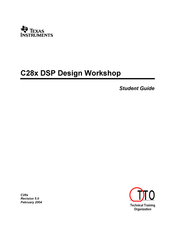Texas Instruments TMS320C28 series Manuals
Manuals and User Guides for Texas Instruments TMS320C28 series. We have 3 Texas Instruments TMS320C28 series manuals available for free PDF download: Student Manual, Reference Manual, User Manual
Texas Instruments TMS320C28 series Student Manual (342 pages)
DSP Design Workshop
Brand: Texas Instruments
|
Category: Computer Hardware
|
Size: 9 MB
Table of Contents
Advertisement
Texas Instruments TMS320C28 series Reference Manual (139 pages)
Floating Point Unit and
Instruction Set
Brand: Texas Instruments
|
Category: Controller
|
Size: 1 MB
Table of Contents
Texas Instruments TMS320C28 series User Manual (76 pages)
Floating Point Unit DSP Library
Brand: Texas Instruments
|
Category: Motherboard
|
Size: 0 MB
Table of Contents
Advertisement
Advertisement
Related Products
- Texas Instruments TMS320C2000
- Texas Instruments TMS320C6455
- Texas Instruments TMS320C6454
- Texas Instruments TMS320C674X
- Texas Instruments TMS320C6452 DSP
- Texas Instruments TMS320C6747 DSP
- Texas Instruments TMS320C674x/OMAP-L1x
- Texas Instruments TMS320C6742
- Texas Instruments TMS320C6743
- Texas Instruments TMS320C6748


